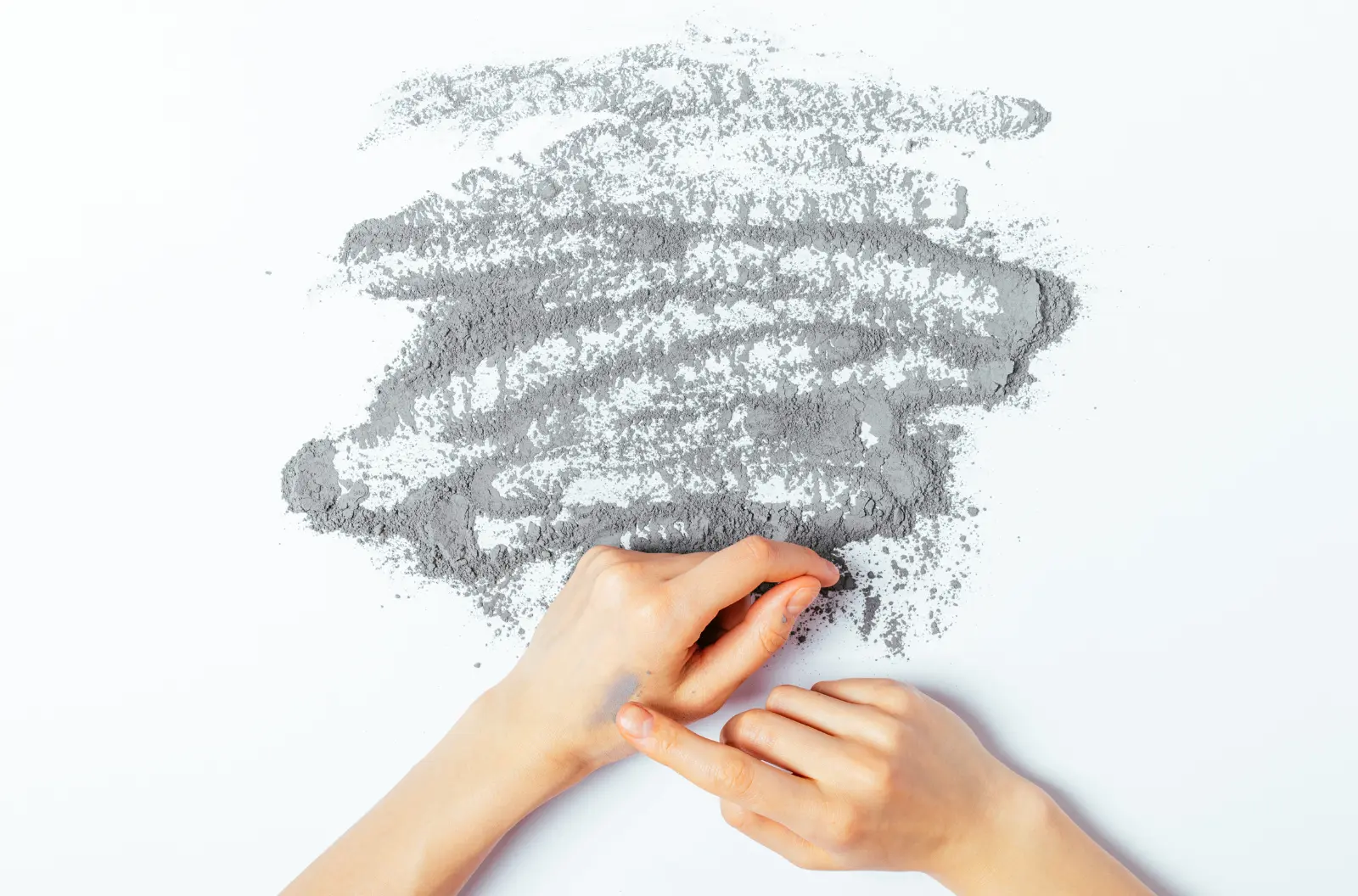Montmorillonite: Montmorillonite is the primary mineral in Bentonite clay and is responsible for its swelling and absorbent properties. This mineral has a layered structure that allows it to absorb water and expand, making it highly effective in drawing out toxins and impurities.
Silica (SiO₂): Silica is a naturally occurring compound found in Bentonite clay, making up about 50-60% of its composition. Silica plays a crucial role in skin and hair health, helping to improve elasticity and strength.
Aluminum (Al₂O₃): Bentonite clay contains approximately 15-20% aluminum oxide. While aluminum is often a concern in other products, in Bentonite clay, it is bound in a way that prevents it from being absorbed by the body, making it safe for external and internal use.
Iron (Fe₂O₃): Iron oxide gives Bentonite clay its earthy color, ranging from cream to grey or even greenish hues. Iron is also a key element that contributes to the clay’s detoxifying properties.
Calcium and Sodium: Bentonite clay can be classified into two types based on the dominant element: calcium Bentonite and sodium Bentonite.
Magnesium (MgO): Magnesium oxide is present in smaller amounts in Bentonite clay, contributing to its overall mineral content and enhancing its healing properties for the skin and body.
In addition to the major components, Bentonite clay also contains trace amounts of other minerals like potassium, titanium, and manganese, which further enrich its composition and contribute to its beneficial effects.
The unique combination of these minerals makes Bentonite clay highly effective for a variety of uses, including detoxification, skin care, hair care, and more. The ability of montmorillonite to swell and bind to toxins is particularly valuable, as it allows Bentonite clay to absorb and remove impurities from the body and environment.
Bentonite clay is renowned for its versatility and has been used for centuries in various cultures for its healing and detoxifying properties. Its ability to absorb impurities, minerals, and toxins makes it a valuable natural remedy for a wide range of applications. Below are some of the key uses and benefits of Bentonite clay:
Bentonite clay is widely used in skin care due to its ability to cleanse, detoxify, and rejuvenate the skin.
Facial Masks: Bentonite clay is a popular ingredient in facial masks, where it helps to draw out impurities, reduce acne, and tighten pores. Its absorbent nature makes it particularly effective for oily and acne-prone skin.
Spot Treatments: For those dealing with specific blemishes or skin irritations, Bentonite clay can be applied directly to the affected area. It helps to reduce inflammation, calm the skin, and promote faster healing.
Detoxifying Baths: Adding Bentonite clay to bathwater creates a detoxifying soak that can help cleanse the skin of toxins and impurities. This is especially beneficial for those with skin conditions like eczema or psoriasis.
Bentonite clay is also beneficial for hair and scalp health.
Hair Masks: When used as a hair mask, Bentonite clay can help remove excess oil, cleanse the scalp, and strengthen hair. It adds volume and shine to hair, making it look healthier and more vibrant.
Scalp Treatments: Bentonite clay is effective in treating dandruff and scalp irritation. It soothes the scalp, reduces inflammation, and promotes a healthy environment for hair growth.
Bentonite clay’s ability to bind to toxins and bacteria makes it a useful ingredient in natural oral care products.
Toothpaste: Bentonite clay can be used as a base for natural toothpaste, helping to remove plaque, whiten teeth, and freshen breath without the use of harsh chemicals.
Mouthwash: A Bentonite clay mouthwash can detoxify the mouth, improve gum health, and eliminate bad breath by binding to and removing toxins and bacteria.
Bentonite clay is often ingested for its detoxifying properties.
Digestive Cleanse: When taken internally, Bentonite clay binds to toxins, heavy metals, and other impurities in the digestive tract, helping to eliminate them from the body. This can improve digestion, reduce bloating, and support overall gut health.
Alkalizing the Body: Bentonite clay can help balance the body’s pH levels, making it more alkaline. This is believed to support overall health and reduce the risk of chronic diseases.
Bentonite clay is not only beneficial for personal health but also has important environmental applications.
Water Purification: Bentonite clay is used in water purification processes to remove contaminants and clarify water. Its absorbent properties make it effective in binding to and removing impurities from water.
Industrial Applications: In industries, Bentonite clay is used as a drilling mud in oil and gas exploration, as a binder in foundry sands, and as a sealant for ponds and landfills due to its ability to swell and create an impermeable barrier.
Bentonite clay is also added to animal feed to improve the health and well-being of livestock.
Detoxification: Just as Bentonite clay detoxifies the human body, it can also help remove toxins from the digestive systems of animals, improving their health and growth rates.
Nutrient Supplement: Bentonite clay provides essential minerals that can supplement the diet of livestock, contributing to their overall well-being.
Bentonite clay is highly regarded for its unique ability to absorb and bind to toxins, heavy metals, and impurities, making it an effective natural remedy for detoxification and cleansing. The way Bentonite clay works can be attributed to its structure, composition, and natural properties.
Bentonite clay operates through two primary mechanisms: absorption and adsorption.
Absorption: Absorption refers to the process by which Bentonite clay soaks up liquids. When Bentonite clay comes into contact with water, it expands and swells as it absorbs the liquid. This ability to absorb moisture makes it useful for a variety of applications, including skin care and hair care, where it helps to draw out excess oil and moisture from the skin and scalp. Adsorption: Adsorption is a surface-based process where Bentonite clay binds to toxins, impurities, and other substances. The clay’s particles have a negative charge, which attracts positively charged toxins and heavy metals. This binding process traps the impurities within the clay’s structure, preventing them from being reabsorbed by the body or skin. Once the toxins are bound, they can be easily washed away or removed, leaving the skin, hair, or digestive system cleaner and healthier. Bentonite clay’s ability to detoxify is further enhanced by its ionic exchange properties. The clay’s particles have a high cation exchange capacity (CEC), meaning they can exchange cations (positively charged ions) with other substances.
Cation Exchange: When Bentonite clay comes into contact with the skin, hair, or digestive system, it exchanges its naturally occurring minerals, such as calcium, magnesium, and potassium, for the toxins and impurities present in the body. This exchange process not only removes harmful substances but also replenishes the body with essential minerals, contributing to improved health and wellness. One of the most distinctive features of Bentonite clay is its ability to swell and expand when it absorbs water. This swelling creates a gel-like consistency that can cover a larger surface area, making it effective for various applications.
In Skin and Hair Care: When applied as a mask or treatment, the expanded clay forms a protective layer over the skin or scalp, allowing it to draw out impurities and absorb excess oil. This swelling action also tightens and tones the skin, making it feel firmer and more refreshed after use. In Environmental and Industrial Applications: The swelling property of Bentonite clay is used to create impermeable barriers in construction and environmental projects. For example, when used as a liner in ponds or landfills, the clay expands to fill gaps and prevent water or contaminants from seeping through. Bentonite clay is naturally alkaline, with a pH of around 8.3 to 9.1. When used internally or applied to the skin, Bentonite clay can help to neutralize acidic conditions.
For Internal Use: When ingested, Bentonite clay can help balance the body’s pH levels by neutralizing excess acidity. This alkalizing effect is believed to support overall health, improve digestion, and reduce the risk of chronic diseases. For Skin Care: The alkalizing properties of Bentonite clay can help soothe and calm irritated or inflamed skin. By balancing the skin’s pH, Bentonite clay can reduce redness, swelling, and other signs of irritation. The combined actions of absorption, adsorption, ionic exchange, and swelling make Bentonite clay a powerful detoxifying agent. Whether used on the skin, hair, or internally, Bentonite clay works to cleanse the body of impurities and toxins, promoting overall health and well-being.
For the Skin: Bentonite clay draws out dirt, oil, and toxins from the pores, leaving the skin cleaner, clearer, and more radiant. For the Hair and Scalp: Bentonite clay removes buildup from the hair and scalp, improving hair texture and promoting a healthy scalp environment. For Internal Use: When ingested, Bentonite clay binds to toxins in the digestive tract, helping to eliminate them from the body and support digestive health. Bentonite clay can vary in color depending on its composition and the location from which it is sourced. The color of Bentonite clay is influenced primarily by the presence of different minerals and the specific type of Bentonite clay.
The most common color of Bentonite clay is a gray to cream hue. This variation in color is typical of calcium Bentonite, which is rich in calcium and other trace minerals. The grayish tone comes from the natural mineral content within the clay, and it often has a slightly off-white appearance.
Some Bentonite clay, particularly that with a higher content of iron and magnesium, can have a greenish-grey tint. This type of clay is often found in areas with higher mineral deposits and is still highly effective for detoxification and other uses.
Bentonite clay can also appear white to pale yellow. This color is more common in highly purified Bentonite clay, where the impurities and additional minerals have been removed. White Bentonite clay is often used in cosmetic products due to its gentle nature and neutral color.
In some cases, Bentonite clay may have a reddish-brown hue, which indicates the presence of higher levels of iron oxide. This type of Bentonite clay is less common and is typically found in specific regions where the soil has a higher iron content.
Understanding what color Bentonite clay is can provide insights into its composition and potential uses. The color does not necessarily affect the effectiveness of the clay, but it can indicate the presence of certain minerals. For example:
Gray to Cream Bentonite Clay: Ideal for skin care, hair care, and internal detoxification due to its balanced mineral content. Greenish-Grey Bentonite Clay: Often preferred for more intensive detoxification processes, given its richer mineral profile. White Bentonite Clay: Suitable for those with sensitive skin or when a more refined, gentle clay is needed. Reddish-Brown Bentonite Clay: Typically used for specific industrial or environmental applications where the higher iron content may be beneficial. By recognizing the color of Bentonite clay, you can choose the type that best suits your needs, whether for personal care, detoxification, or other applications.
Bentonite clay is not something that can be “made” in the traditional sense, as it is a natural mineral formed from volcanic ash over millions of years. However, you can prepare Bentonite clay for various applications by activating it and ensuring it is in the right form for your intended use. Here’s a clear and straightforward guide on how to prepare and make Bentonite clay ready for use in your health and beauty routines.
The first step in how to make Bentonite clay ready for use is sourcing high-quality, pure Bentonite clay. You can purchase food-grade or cosmetic-grade Bentonite clay from reputable suppliers. Ensure that the clay is free from additives, fillers, and contaminants.
Once you have sourced your Bentonite clay, follow these steps to prepare it for use:
Measure the Clay: Take the desired amount of Bentonite clay powder. For a face mask, 1-2 tablespoons is usually sufficient. For a hair mask, you may need 3-4 tablespoons depending on hair length.
Add Liquid: Gradually add water or apple cider vinegar to the clay powder. Start with a small amount and slowly add more until the mixture reaches a smooth, paste-like consistency. Apple cider vinegar is often used for its additional skin benefits and to create a smoother mixture.
Mix Well: Use a non-metallic spoon and bowl to mix the clay and liquid. Bentonite clay reacts with metal, which can reduce its effectiveness. Stir the mixture until it is free of lumps and has a uniform texture.
Apply: Your Bentonite clay is now ready to be applied as a mask or treatment for the skin or hair.
Hydrate the Clay: If you plan to ingest Bentonite clay for detoxification purposes, it’s important to fully hydrate the clay. Add 1/2 to 1 teaspoon of Bentonite clay powder to 8 ounces of water. Stir well using a non-metallic spoon.
Let it Sit: Allow the mixture to sit for at least 5-10 minutes. This gives the clay time to fully absorb the water and expand, which enhances its detoxifying properties.
Consume: Once the clay has settled and the water has turned cloudy, the mixture is ready to drink. Be sure to follow the recommended dosage and consult with a healthcare provider before beginning any detox regimen.
After preparing Bentonite clay, proper storage is key to maintaining its effectiveness:
Store in a Cool, Dry Place: Keep your Bentonite clay powder in an airtight container in a cool, dry place. This helps to prevent moisture from affecting the clay’s absorbent properties.
Avoid Metal Containers: As mentioned earlier, Bentonite clay should not come into contact with metal, as this can deactivate its beneficial properties. Use glass, plastic, or ceramic containers for storage.
The process of how to make Bentonite clay ready for use is simple but crucial in ensuring that you get the maximum benefits from this powerful natural substance. Whether you’re preparing it for a detoxifying face mask, a hair treatment, or internal detoxification, following these steps will help you make the most of Bentonite clay’s unique properties.
Mixing Bentonite clay correctly is essential to unlocking its full potential for skin care, hair care, or internal detoxification. The process is simple but must be done carefully to ensure that the clay retains its beneficial properties. Here’s a detailed guide on how to mix Bentonite clay for various uses.
Before you begin, ensure you have the following materials:
Bentonite Clay Powder: Start with a high-quality, pure Bentonite clay powder. Make sure it is food-grade if you intend to use it internally.
Liquid: Depending on your intended use, you can mix the clay with water, apple cider vinegar, or other suitable liquids. Water is generally used for hair and skin applications, while apple cider vinegar is often preferred for face masks due to its additional skin benefits.
Non-Metallic Bowl and Spoon: It’s crucial to use a plastic, wooden, or ceramic bowl and spoon, as Bentonite clay reacts with metal, reducing its effectiveness.
For Face Masks: Measure out 1-2 tablespoons of Bentonite clay powder.
For Hair Masks: You may need 3-4 tablespoons, depending on the length and thickness of your hair.
For Internal Use: If ingesting, start with 1/2 to 1 teaspoon of Bentonite clay powder.
Start Slowly: Pour a small amount of liquid (water or apple cider vinegar) into the bowl with the Bentonite clay powder. Start with a small quantity, as it’s easier to add more liquid if needed than to adjust the mixture if it becomes too runny.
Mix Gradually: As you add the liquid, mix the clay using a non-metallic spoon. Stir the mixture slowly to avoid lumps and ensure the liquid is evenly distributed throughout the clay.
Smooth Paste: For most skin and hair applications, you want to achieve a smooth, thick paste. The consistency should be similar to yogurt—thick enough to stay on your skin or hair without dripping, but not so thick that it’s difficult to spread.
Thicker Mixture: If you’re preparing a clay pack for spot treatments or a hair mask, you may want the mixture to be slightly thicker.
Thinner Mixture: For internal use, the mixture should be more liquid to ensure easy ingestion. If drinking, mix 1/2 to 1 teaspoon of clay with 8 ounces of water and stir until fully dissolved.
Allow to Hydrate: After mixing, let the Bentonite clay mixture sit for a few minutes. This gives the clay time to fully absorb the liquid, enhancing its ability to draw out impurities and toxins.
Final Stir: Before applying or consuming the mixture, give it a final stir to ensure an even consistency.
Skin Care: Apply the clay mixture evenly to the skin, avoiding the sensitive eye area. Leave it on for 10-15 minutes before rinsing off with warm water.
Hair Care: Apply the mixture to the scalp and hair, ensuring even coverage. Leave it on for 15-20 minutes before rinsing thoroughly.
Internal Use: Drink the prepared mixture on an empty stomach, and follow with a glass of water to aid in the detoxification process.
Knowing how to mix Bentonite clay properly is key to maximizing its benefits, whether you’re using it for external applications like face masks and hair treatments or internal detoxification. By following these steps carefully, you can ensure that your Bentonite clay mixture is effective, safe, and ready to provide the natural health benefits you’re looking for.
Bentonite clay is a versatile natural remedy with numerous benefits. Understanding what Bentonite clay is made of, what it’s good for, how it works, and how to make and mix it ensures you can effectively use it for skin care, hair care, and internal detoxification. Whether you’re exploring its gray, greenish, or white varieties, knowing how to make Bentonite clay ready for use and how to mix Bentonite clay correctly can help you maximize its potential. Incorporate Bentonite clay into your routine to enjoy its detoxifying, healing, and beautifying properties.





